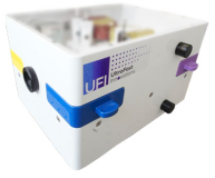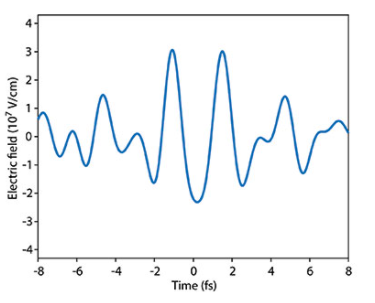This articles discusses light (electromagnetic radiation) sythensis using a specifically designed emitter.
Ultrafast light field synthesis is performed through the spectral division of a coherent supercontinuum into three different bands (channels) by chirped dichroic beamsplitters. Using an interferometric spatio-temporal superposition a field waveform can be controlled and synthesized. All constituent pulses from the channels of CAPELLA are temporally compressed by chirped mirrors down to pulse duration of <10 fs. Introducing different time-delays among the channels enables the shaping and sub-cycle control of the field waveform.
 | Left: Spectral splitting of the different channels. Center: Parallel channel compression and temporal overlap with attosecond resolution. Right: Passive interferometric stability between different channels over more than an hour. |
CAPELLA
We present the first commercial Light Field Synthesizer enabling synthesis and sub-femtosecond control of super-octave light transients. Due to its solidness, compactness and excellent thermal capabilities, CAPELLA can maintain the optical pathlength stable among the different channels for many hours. Furthermore, an extra active-controlled loop improves the interferometric stability to <50 mrad. Apart from the generation of waveforms, CAPELLA offers the shortest
pulses available in market to date, see below:

Key Product Features
Shortest pulse available 2 fs FWHM Overall transmission >60% @ 9 mm beam >70% @ 7 mm beam Parallel pulse compression of multiple channels: <9 fs (700-1000 nm) <8 fs (500-700 nm) <10 fs (400-500 nm)
Attosecond-scale delay among the channels Interferometric stability Short term passive stability: <100 mrad Long term active-loop stability: <50 mrad
Incident polarization: s or p polarization Laptop and user-friendly software interface included Small Footprint: 30 x 20 cm2 |  
|
| Specifications | Capella |
| Number of channels | 3
|
| Wavelength range | 400-1000 nm
|
| Required Input energy | >290 µJ (700-1000 nm) | >60 µJ (500-700 nm) | >14 µJ (400-500 nm) |
| Polarization | s- or p-polarized input light |
| Introduced dispersion | > -380 fs2 | > -370 fs2 | > -560 fs2 |
| Temporal accuracy | 2 nm = 7 as |
| Maximum delay | 60 ps |
| Optics size | 0.5 inch |
| Overall transmission | >60% @9 mm beam >70% @7 mm beam |